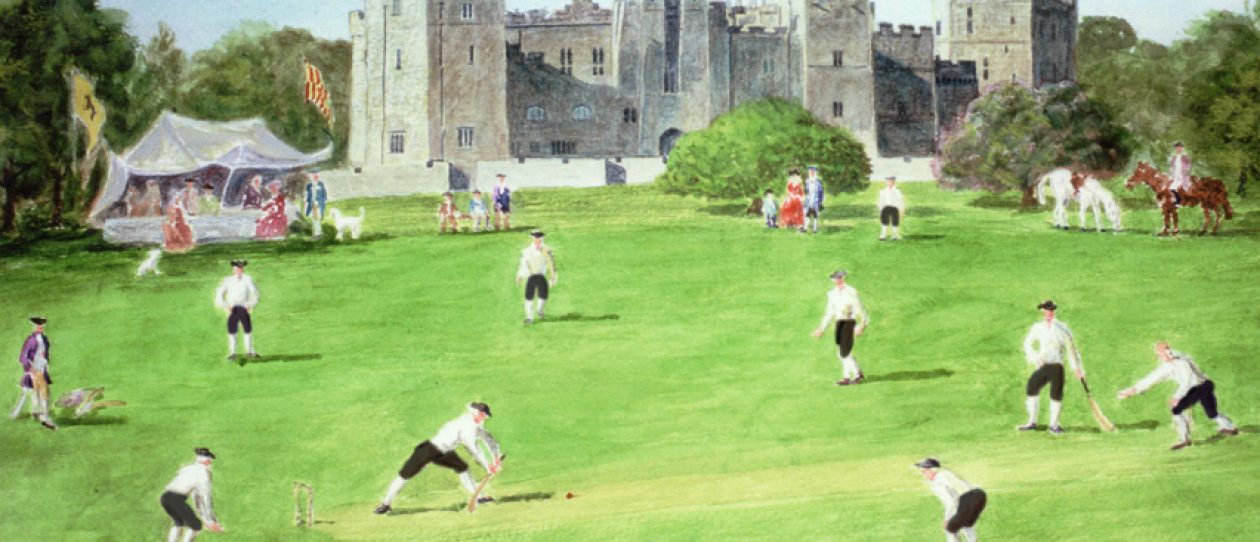Raby Castle provided a regal setting for the first known match. Other venues were less grand and usually on the outskirts of towns and villages close by a tavern where astute landlords profited from sub-letting fields and providing dinner and refreshments. Pitches were prepared using forks, watering-cans and turf-beaters. Siting a wicket was a subtle art whereby home bowlers took advantage of the ridges and hollows. Outfields received less attention and, unless leased for sheep-grazing, long grass made scoring difficult.
The first known cricket ground at Bishopwearmouth “commanded a beautiful marine view”. Facilities were added for the “comfort and convenience of their opponents.” Colourful tented pavilions and booths circled the field. They were treated with Margery’s patent anti-mildew preventive, a solution used by yachtsmen. Darlington built “a large wooden erection” in 1837 for serving dinners and Sunderland built a ladies’ stand in 1848. Tom Hornby handled the purchase of Grangefield and noted its smoothness compared with the “rough, ragged grass” in his days at Stockton. Turf from an old ground was often transported to the new. Shotley Bridge used turf from the fells above the River Derwent. New grounds were laid out for around £1,000 and pitches were cut and rolled by a horse with leather over-shoes attached to its hooves. One grey nag at South Shields dropped dead just three days after purchase. Another was put to different use by Mr Nash, the Seaton Carew groundsman who rode off on it and was never seen again.
Grounds were at the prey of property developers. Darlington’s Park Street was acquired for high-density housing; Sunderland’s Holmeside annexed to make way for a railway. Consett had to cede their ground to the iron works; Stockton’s field became a public park. Whitburn were in danger of losing their ground in 1995. The loss of their ground on the site of Whitburn Hall would have been tragic. One senses its original beauty. The boundary is edged by the remains of a Grecian column terrace where Sir Hedworth Williamson and his house-guests watched the cricket. Entrance to the Hall was through iron gates embellished with delicate wrought-iron tracery of rambling roses, thorns, leaves and berries.
Timber-built pavilions were the next major development. South Shields paid £450 for a pavilion with balcony, veranda, changing rooms and scorebox high in a corner turret. Smaller clubs used converted railway carriages, old army huts or simple structures built by volunteer members. Many went up in flames, destroying precious club records in the process.
They were replaced by brick buildings. North Durham’s pavilion, designed by club member Robert Snowdon, also cost £450. It measured 62 feet by 22 feet, was faced with best red-dressed Birtley brick and had a wrought-iron roof and cast-iron support columns. Cladded throughout, the ground floor contained three dressing rooms. The upper storey had an office, ladies’ cloakroom and a refreshment room with French casement opening onto a veranda. Ashbrooke’s red-tiled pavilion was designed by James Henderson. The home dressing-room and a ladies’ room were on the ground floor. Visitors changed upstairs next to the committee room. The attractive frontage had a white-painted balcony, a clock below the eaves, and a round carillon perched on the ridge tiles. Two wings were added in 1931. Opened in 1906, Feethams was constructed on a five-tier concrete grandstand. The ground floor contained rooms for the committee, refreshments and cloaks. The first floor had changing rooms and function room with sliding doors opening onto a balcony. An upper balcony was added in 1909 to hold up to 80 people.
The next stage was to enclose grounds, add scorebox and seating, and lay on water and lighting. Barnard Castle and Seaham Harbour were among the first to provide teas for spectators in the 1890s. It was a popular innovation. Spectators scurried to Consett’s tea-room, sixpence in hand, for “fragrant tea and delicious cakes provided by the fair sex”. Within half-an-hour only bread and butter remained. Stockton’s lovely tea-room is still used today. When September sun filters through its window tracery the atmosphere is delicate and redolent of a bygone age. The heart aches to think that in 1914, after all the toil, grounds were in the hands of the military. North Durham was sliced open with trenches. The match on 3 June 1922 was the first at Prince Consort Road for 2,854 days.
